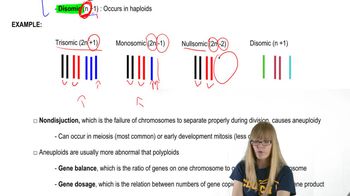An attached-X female fly, XXY, expresses the recessive X-linked white-eye mutation. It is crossed to a male fly that expresses the X-linked recessive miniature-wing mutation. Determine the outcome of this cross in terms of sex, eye color, and wing size of the offspring.
Table of contents
- 1. Introduction to Genetics51m
- 2. Mendel's Laws of Inheritance3h 37m
- 3. Extensions to Mendelian Inheritance2h 41m
- 4. Genetic Mapping and Linkage2h 28m
- 5. Genetics of Bacteria and Viruses1h 21m
- 6. Chromosomal Variation1h 48m
- 7. DNA and Chromosome Structure56m
- 8. DNA Replication1h 10m
- 9. Mitosis and Meiosis1h 34m
- 10. Transcription1h 0m
- 11. Translation58m
- 12. Gene Regulation in Prokaryotes1h 19m
- 13. Gene Regulation in Eukaryotes44m
- 14. Genetic Control of Development44m
- 15. Genomes and Genomics1h 50m
- 16. Transposable Elements47m
- 17. Mutation, Repair, and Recombination1h 6m
- 18. Molecular Genetic Tools19m
- 19. Cancer Genetics29m
- 20. Quantitative Genetics1h 26m
- 21. Population Genetics50m
- 22. Evolutionary Genetics29m
6. Chromosomal Variation
Chromosomal Mutations: Aneuploidy
Problem 17b
Textbook Question
Drosophila may be monosomic for chromosome 4, yet remain fertile. Contrast the F₁ and F₂ results of the following crosses involving the recessive chromosome 4 trait, bent bristles:
monosomic IV, normal bristles x diploid, bent bristles.
 Verified step by step guidance
Verified step by step guidance1
Step 1: Understand the genetic setup of the problem. Monosomic IV means the individual has only one copy of chromosome 4 instead of the usual two. The diploid individual has two copies of chromosome 4. The trait 'bent bristles' is recessive, meaning it is expressed only when both copies of the gene on chromosome 4 are the recessive allele.
Step 2: Assign symbols to the alleles. Let 'B' represent the dominant allele for normal bristles and 'b' represent the recessive allele for bent bristles. The monosomic individual will have only one allele for this trait (e.g., B or b), while the diploid individual will have two alleles (e.g., Bb or bb).
Step 3: Determine the genotypes of the parents. The monosomic individual could be either B (normal bristles) or b (bent bristles), while the diploid individual is bb (bent bristles) based on the problem description.
Step 4: Predict the F₁ generation. Perform a Punnett square or equivalent analysis to determine the possible genotypes and phenotypes of the offspring. Remember that the monosomic parent contributes only one allele, while the diploid parent contributes two alleles. For example, if the monosomic parent is B, the F₁ offspring will inherit either B or b from the diploid parent, resulting in genotypes Bb (normal bristles) or bb (bent bristles).
Step 5: Predict the F₂ generation. If the F₁ individuals are allowed to self-cross or interbreed, perform another Punnett square to determine the genotypic and phenotypic ratios in the F₂ generation. Consider the inheritance patterns of the recessive trait and the monosomic condition when analyzing the results.
 Verified video answer for a similar problem:
Verified video answer for a similar problem:This video solution was recommended by our tutors as helpful for the problem above
Video duration:
2mPlay a video:
Was this helpful?
Key Concepts
Here are the essential concepts you must grasp in order to answer the question correctly.
Monosomy
Monosomy refers to the condition in which an organism has only one copy of a particular chromosome instead of the usual two. In Drosophila, being monosomic for chromosome 4 means that there is a single copy of this chromosome, which can lead to specific phenotypic expressions, such as the presence of recessive traits. Despite this chromosomal deficiency, organisms can still be fertile, indicating that certain genetic functions can be compensated by other mechanisms.
Recommended video:
Guided course

Aneuploidy
Recessive Traits
Recessive traits are characteristics that are expressed only when an individual has two copies of the recessive allele. In the context of the bent bristles trait in Drosophila, this means that a fly must inherit the bent bristles allele from both parents to exhibit the phenotype. If one parent is monosomic for chromosome 4 and carries the normal bristles allele, the offspring may show a mix of phenotypes depending on the genetic contributions from both parents.
Recommended video:
Guided course

Traits and Variance
F₁ and F₂ Generations
The F₁ generation is the first filial generation resulting from a cross between two parental lines, while the F₂ generation is produced by interbreeding the F₁ individuals. In genetic crosses, analyzing the phenotypic ratios in these generations helps to understand inheritance patterns. In this case, the F₁ generation will reveal the dominance of the normal bristles trait, while the F₂ generation will provide insights into the segregation of the recessive bent bristles trait, allowing for predictions about offspring phenotypes.
Recommended video:
Guided course

F Factor and Hfr
Related Videos
Related Practice
Textbook Question
718
views


